Share





Kurt Manufacturing Company
Featured Content
View More

Takumi USA
Featured Content
View More
Hwacheon Machinery America, Inc.
Featured Content
View More
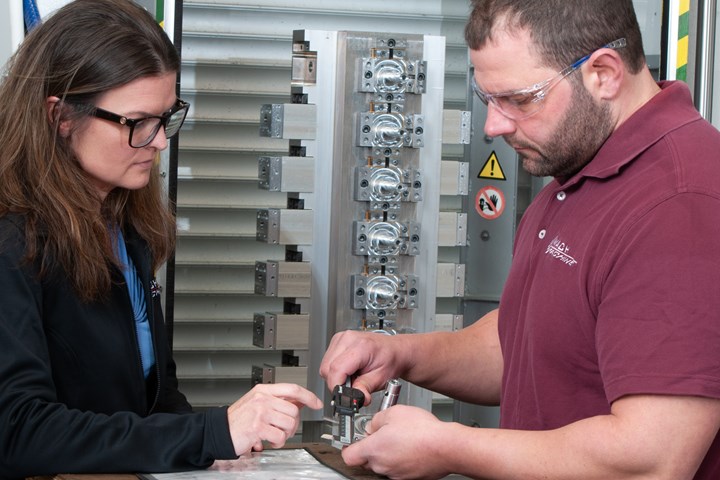
In front of the loading station of the shop’s Fastems FPC flexible pallet container, Angela Olsen and Mach Machine President Dan Olsen check the dimensions of lens mount components.
In 2004, Dan Olsen co-founded the e-commerce site BoatZincs.com to distribute a selection of specialized marine products including “zincs,” the anti-corrosion anodes attached to boat hulls) to recreational and commercial boaters. To meet particular customer needs, BoatZincs added basic manufacturing capabilities and later began to offer machining services to businesses outside the marine industry. Today, with heavy emphasis on creative process development and automation, including advanced Okuma horizontal machining centers (HMCs) linked with an intelligent Fastems flexible manufacturing system, BoatZincs’ offshoot manufacturing business, Mach Machine, handles prototype and production runs of precision parts for customers in the high-tech, medical, aerospace and military industries, among others.
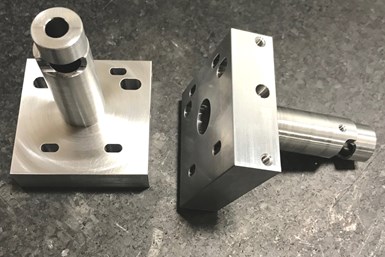
The shop previously mounted a custom trunnion on the rotary table of a VMC to machine five sides of this laser lens mount. Now, the operation has moved to the shop’s Fastems automation system. Since the move, cycle time was reduced by nearly 60 percent.
While Mach Machine’s entry into horizontal machining and pallet automation has been quite successful, it initially felt like a jump into the deep end of the pool.
Homegrown Metalworking Becomes Profitable
The Hudson, Massachusetts, company started making some of its own products when Mr. Olsen received customer requests for a propellor anode that BoatZinc’s suppliers were reluctant to produce because of tooling costs and demand speculation. “That’s when we decided to reverse engineer the part and start manufacturing these parts ourselves,” Mr. Olsen says. “We built our own small furnace and started die casting in my driveway.”
Mr. Olsen has engineering and business degrees but no formal training as a machinist. He taught himself how to machine die casting tooling and parts after buying CAD/CAM software and using it to generate G code. Starting with a single CNC bed mill, the list of non-marine customers grew until Mr. Olsen decided to create Mach Machine Inc.
To handle a large contract from a laser equipment company that involved machining five sides of a lens mount, Mr. Olsen designed a custom trunnion table and mounted it on the rotary table of the VMC. The arrangement indexed the part to different positions and permitted four-axis positional machining without the need for multiple setups. Mach Machine was able to machine all sides of the mount in a cycle time of about 24 minutes. “We had a good rate on that part, and it turned out to be pretty profitable,” Mr. Olsen says.
The shop soon had two CNC vertical machining centers and a turning center.
Diving into Horizontal Machining and Automation
As the shop’s production mix and volume grew, the time required to construct multiple setups grew as well. After watching an employee take four hours to perform a setup that repeated every month, Mr. Olsen says, “I realized it was time to investigate the use of a horizontal machining center that would enable us to design and build fixturing setups on tombstones and leave them in place permanently.” While Mr. Olsen was researching HMCs, his Okuma representative invited him to a demonstration of an Okuma HMC and a flexible pallet container (FPC) from Fastems LLC. “At the time, I was a little bit taken back because I just wanted to get my feet wet in the horizontal machining area. This was more like taking a dive!” he says. “But I realized that we didn’t have just one job that could go on this machine, we actually had dozens.” The demonstration convinced Mr. Olsen to purchase an Okuma MB-5000H HMC and a 12-pallet Fastems FPC with an MMS5 control.
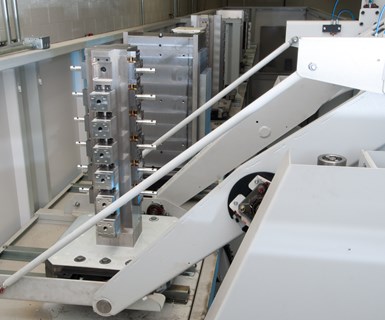
A pallet loaded with fixtured workpieces on a tombstone is placed into the machining queue in the Fastems FPC. Though in a queue, these might be machined at night or the next day because other jobs have higher priority. “The software doesn’t just run through pallets 1, 2, 3, 4 and 5 sequentially,” Dan Olsen says. “It actually looks at everything that needs to be manufactured and when jobs need to be done.”
The equipment’s productivity and efficiency prompted Mach Machine to use it for a growing amount of work, including both aluminum and stainless steel parts. That said, maintaining a single HMC running different alloys was difficult in terms of clearing out chips and changing collection bins to avoid mixing chips. As a result the company added a second MB 5000 and expanded the Fastems FPC to 24 pallets. It now has two dedicated machines, one for aluminum, one for stainless steel, and they’re busy, Mr. Olsen says.
In addition to streamlining the setup process, the combination of the HMCs and the Fastems FPC system also produces significant cycle-time savings. Cycle time on the lens-mount part decreased from 24 minutes to 10 minutes per piece when the shop moved machining to the HMC/FPC system. “The fixturing is designed specifically for the part, so we’re able to utilize the whole work envelope of the machine,” Mr. Olsen says. “Permanent fixturing also gives us excellent part-to-part repeatability.”
Blanket purchase orders with monthly deliveries comprise most of the work that goes into the FPC. “Once the jobs are in there, they’re there permanently. That makes the re-running of the job like gravy at that point,” Mr. Olsen says.
How Automation Affects Employees and Capabilities
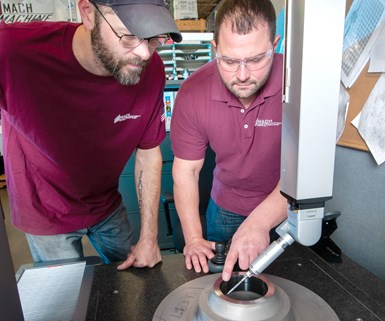
Dan Olsen and shop manager Matt check dimensions of a turbine rotor on the shop’s Hexagon Global 7-10-7 coordinate measuring machine (CMM). “Now that we have efficient manufacturing capabilities in place, we’re focusing on developing a first-rate quality department,” Mr. Olsen says.
According to Mr. Olsen, automation at Mach Machine hasn’t resulted in staff reductions; quite the opposite: “We’ve been hiring right along because we’re able to produce so much more. That creates a lot of opportunities, whether they are in shipping or receiving or in quality control.” He notes that the employee mix of advanced manufacturing differs from traditional manufacturing: “You don’t necessarily need operators standing at the machining center, but you do need people with engineering backgrounds, good programming skills and good understanding of manufacturing and materials.”
Regarding tool management, the Fastems FPC software collects machine data that facilitates proactive tooling strategies. The system collects wear and breakage information for every tool and uses that data to optimize tool application. For example, if data show that a certain drill often breaks or wears out after drilling 500 holes in a particular part, the software can prompt replacement when the tool completes 450 holes. Rework due to tool failure is minimized, and the shop’s yield rate of over 99.5 percent annually reflects that, Mr. Olsen says.
Fastems software also manages the sequencing of different jobs to maximize efficiency, resource utilization and delivery time. When the raw material needed for a job arrives on site, the shop sends a job traveler file to the machine. The operator enters the job number, part number, quantity and due date. Permanently setup, job-specific pallets are brought to the load station via the automated FPC stacker crane, and the operator loads them with raw material. From there, the software manages when machining will occur. Even though a job is queued up and ready to go, it might be machined at night or the next day because other jobs have higher priority. When machining is complete, the software records an inventory of all the finished parts and moves them out of the system and on to inspection and shipping.
“Now that we have efficient manufacturing capabilities in place, we’re focusing on developing a first-rate quality department,” Mr. Olsen says, “Bringing this piece of equipment online and automating it is a big priority for us.” An upcoming seven-year contract for turned aerospace components will require 100 percent inspection of all parts. As a result, Mach Machine bought a new coordinate measuring machine (CMM) with a full scanning head. Mr. Olsen and his staff are taking steps to automate the system to make it as easy as possible to verify parts dimensionally.
Mr. Olsen is exploring the possibility of integrating the automated inspection process with the Fastems FPC to provide feedback to the machine and enable in-process adjustments.
Investing in More Than Present Needs
According to Mr. Olsen, setting up the FPC—designing tombstone fixtures, making tooling selections and programming the operations—was not easy at first. However, “Once we got that first job in rotation, it progressively got easier and easier,” he says. “We now have a process, so when we put a new job in, we know what we have to do and what to expect.”
He adds that the financial commitment involved in implementing an FPC might scare away some shop owners. Mr. Olsen advises shop owners not to be overwhelmed. In his experience, “You just need to be patient and reach out to the manufacturer’s tech support, online resources like YouTube and online forums to find answers.”
“I’ve always been a firm believer that if I need to buy a piece of equipment, I don’t buy just enough technology for what I need,” Mr. Olsen says. “I always try to buy more than I need because it gives me flexibility to grow. Every time we’ve done that, we’ve always been able to utilize the technology at some point in time.” He continues: “The newer technology is faster, it makes higher-quality parts. Once we went in that direction, we saw huge gains in overall performance. You might pay a little bit more on the upfront than buying something used, but what you’re getting is a superior piece of technology.”
Related Content
Ballbar Testing Benefits Low-Volume Manufacturing
Thanks to ballbar testing with a Renishaw QC20-W, the Autodesk Technology Centers now have more confidence in their machine tools.
Read More5 Tips for Running a Profitable Aerospace Shop
Aerospace machining is a demanding and competitive sector of manufacturing, but this shop demonstrates five ways to find aerospace success.
Read MoreInside the Premium Machine Shop Making Fasteners
AMPG can’t help but take risks — its management doesn’t know how to run machines. But these risks have enabled it to become a runaway success in its market.
Read MoreWhere Micro-Laser Machining Is the Focus
A company that was once a consulting firm has become a successful micro-laser machine shop producing complex parts and features that most traditional CNC shops cannot machine.
Read MoreRead Next
Registration Now Open for the Precision Machining Technology Show (PMTS) 2025
The precision machining industry’s premier event returns to Cleveland, OH, April 1-3.
Read MoreBuilding Out a Foundation for Student Machinists
Autodesk and Haas have teamed up to produce an introductory course for students that covers the basics of CAD, CAM and CNC while providing them with a portfolio part.
Read More5 Rules of Thumb for Buying CNC Machine Tools
Use these tips to carefully plan your machine tool purchases and to avoid regretting your decision later.
Read More
































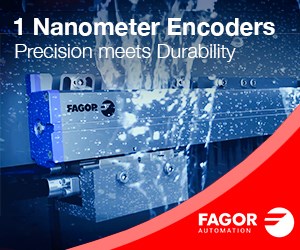



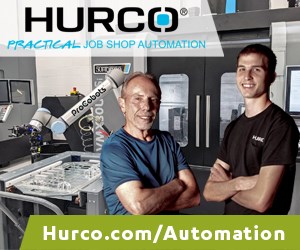





.jpg;maxWidth=300;quality=90)

.jpg;maxWidth=300;quality=90)







